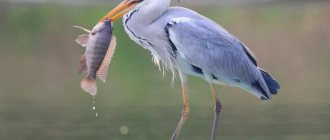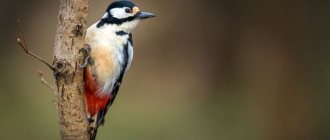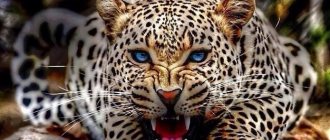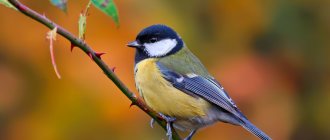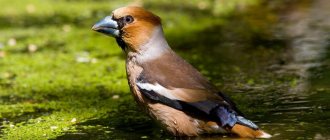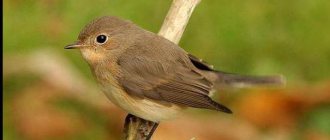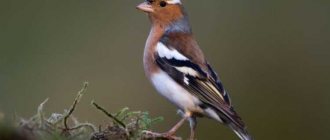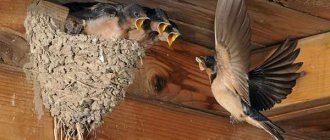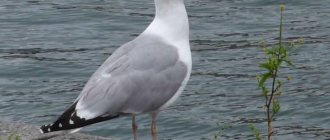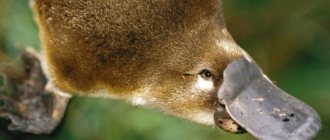- Wild animals
- >>
- Birds
The pheasant is a domesticated bird belonging to the order Galliformes. These Eurasian birds are popular in households and are often raised for hunting. The bird is very attractive in appearance and has bright plumage. Meat is considered dietary and is considered a delicacy on the world market. The pheasant in its natural environment is an extremely shy animal. He likes to live in solitude, so it is difficult to get a photo of a pheasant, because... he rarely finds himself in front of a camera lens.
Origin of the species and description
Photo: Pheasant
This species was first scientifically described by Linnaeus in Systema naturae under its current scientific name. This bird was widely discussed even before Linnaeus established its nomenclature. The common pheasant was simply called “pheasant” in most ornithology textbooks of that time. Pheasants are not native birds to Central Europe. They were brought there during the Roman Empire from Asia, as hunting game many centuries ago. Even today, most pheasants are artificially incubated in some areas and then released for hunting.
Video: Pheasant
Some wild subspecies have long been among the favorite ornamental birds, and therefore have long been bred in captivity, although they could not yet be called domesticated. The homeland of birds is Asia, the Caucasus. They got their name from the ancient Greeks, who discovered birds near the Phasis River (current name Rioni), near the Black Sea and the Georgian settlement of Poti. The common pheasant is the national Georgian bird. The national dish chakhokhbili was made from its fillet. These Caucasian birds constituted the bulk of the introduced stock in Europe until the modern era.
The bird is not found in Africa, except in Mediterranean coastal areas, in the time of Linnaeus, where they may have been introduced during Roman times. These birds had more features in common with the Transcaucasian population than with others. The scientific name is Latin for "pheasant from Colchis", which is located west of modern Georgia. The Ancient Greek term corresponding to the English "pheasant" is Phasianos ornis (Φασιανὸς ὂρνις), "bird of the river Phasis". Linnaeus included many other species in the genus Phasianius, such as the domestic chicken and its wild ancestor. Today, this genus includes only the common and green pheasant. Since the latter was not known to Linnaeus in 1758.
Gold
This breed is distinguished by its special majesty and beauty of plumage. Bred for meat and for decorative purposes. The bird lives in Eastern Europe. It can be found in nature reserves; in other areas it is a rare visitor. But the homeland of the Golden Pheasant is not Europe, but Southwestern China and Eastern Tibet.
Description. The main difference of the breed is its golden crest, along the edges of which there is a black outline. The belly is dark burgundy. Females do not have a crest. The feather color of males combines yellow, orange, black, ocher and blue shades. The neck is decorated with an orange “collar” with a dark border. The tail is long and luxurious. Females are smaller in size and more modest in plumage.
Productivity. Average weight – 1.3 kg. There are 7-10 or more eggs in a clutch. During a season, a female can lay up to 45 eggs, young ones – up to 20 eggs. The peculiarity of the golden pheasant is that if you take the eggs right away, the egg production increases.
Other features. Meat with excellent taste. Disadvantage: weak immunity.
Maintenance and care. Breeding is not particularly difficult. Since the bird is prone to diseases, it is recommended to give it antibiotics along with feed. Although golden pheasants have low immunity, they tolerate frost well - they can withstand temperatures down to minus 35 degrees without harm to their health. This bird can be kept in unheated areas. Find more information about the golden pheasant and its cultivation here.
The golden pheasant has several interesting subspecies. They occur naturally, and breeders also have them:
- Red pheasant. This is a wild variety of Golden Pheasant, introduced to breeders after the work of breeders.
- Bordeaux. It has a color similar to the Golden Pheasant, but instead of red feathers it has burgundy feathers. This species was the first to be bred from the domesticated red pheasant.
- Golden Gigi. He got his name in honor of the Italian Gigi, who was involved in his breeding. A distinctive feature of the species is that the entire body is covered with yellow-green plumage.
- Cinnamon. This species was bred in the USA. Instead of blue and green plumage, it has gray feathers on its back.
Golden Pheasant (Chrysolophus pictus)
Golden pheasant red
Golden pheasant Bordeaux
Golden Gigi
Golden Cinnamon (Cinnamon)
Appearance and features
Photo: Pheasant bird
Common pheasants are medium-sized birds with deep, pear-shaped bodies, small heads and long, slender tails. The sexes have pronounced sexual dimorphism in plumage and size, with males being more colorful and larger than females. Males have impressive multi-colored plumage with long, pointed tails and fleshy red patches around the eyes.
Their heads range in color from glossy dark green to iridescent purple. Many subspecies have a distinctive white collar around the neck, which gives them the name "round-neck". Females are less colorful. They have bright brown, spotted plumage and, like the males, long, pointed tails, although shorter than those of the males.
There are two main groups of subspecies:
- colchicus group with a ring on the neck, are native to mainland Eurasia. There are thirty-one subspecies;
- versicolor group, copper pheasant without ring. It is green on the neck, chest and upper abdomen. This group hails from Japan and was introduced to Hawaii. Has three subspecies.
Body length is 70-90 cm in the male (about 45-60 cm is a long pointed tail) and 55-70 cm in the female (tail length is about 20-26 cm). The wing length of the male is from 230 to 267 mm, of the female from 218 to 237 mm. Some subspecies are large. The weight of a male is from 1.4 to 1.5 kg, females - from 1.1 to 1.4 kg.
Diamond
This is one of the most beautiful birds in the world. The second name of the diamond pheasant is Lady Amhrest, received in honor of the wife of the Governor General, who sent the bird to London from India. From there, the diamond pheasant spread throughout Europe.
Description. The pheasant was called Diamond for a reason; its plumage shimmers like a precious stone. On the head there are wide white feathers, similar to an old wig. The chest is olive or emerald, turning into a white belly. The crop has a combination of white and black feathers. On the back there is blue-black plumage. The bird's tail is especially luxurious. Females look traditionally modest - brownish-motley plumage, bluish skin around the eyes.
Productivity. The average weight of a male is 0.9-1.3 kg. Female – 0.8 kg. There are 7-10 or more eggs in a clutch. The female is capable of laying up to 30 eggs per season.
Other features. Birds have high adaptive abilities. They can get along with other types of birds - chickens, pigeons, etc. They have a calm, peaceful disposition, are not shy, and easily make contact with people. Diamond pheasant meat is dietary, very tender and pleasant to the taste. Eggs are high in protein.
Maintenance and care. The bird, despite its exotic appearance, tolerates cold well and is not demanding on living conditions. It is easy to breed in private backyards. They are housed in spacious enclosures in families, but one male – two females. The enclosure should be divided into zones for pairs. To help birds gain weight faster, they are given fish oil. The rest of the diet is similar to chicken. Eats greens, grains, worms, vegetables and fruits. Bred for hunting and decorative purposes.
Where does the pheasant live?
Photo: Pheasant in nature
The pheasant is a non-migratory species living in Eurasia. The natural distribution zone of the pheasant passes through the south of the Central and Eastern Palearctic, as well as parts of the eastern region. The range extends from the Black Sea in a wide belt south of the forest and steppe zone east to western Chinese Qinghai and the southern edge of the Gobi region, including Korea, Japan and the former Burma. It is present in Europe, North America, New Zealand, Australia and Hawaii. In North America, pheasant populations range across mid-latitude agricultural lands from southern Canada to Utah, California, and south into Virginia.
Interesting fact: The settlement areas are very fragmented, part of the population consists of separate subspecies isolated from each other. On the other hand, east of extreme southeastern Siberia and northeastern China, a large closed area extends south through most of China, as well as Korea and Taiwan north of Vietnam, Laos, Thailand and Myanmar, where transitions between subspecies are less noticeable .
Additionally, the species has been naturalized in many parts of the world with varying degrees of success. Today it lives throughout most of Europe. These birds are rare only in Greece, the Italian Alps and parts of southern France. In the Iberian Peninsula and northern Scandinavia it is almost completely absent. In places there are in Chile.
Pheasants occupy meadows and agricultural land. These birds are generalists and occupy a wide range of habitat types, excluding areas with dense tropical forests, alpine forests or very dry areas. This flexibility allows them to explore new habitats. Open water is not essential for pheasants, but most populations are found where water is present. In drier areas, birds obtain water from dew, insects and succulent vegetation.
Now you know where the bird of the pheasant family lives. Let's see what she eats.
Royal
This is the largest pheasant, which is bred mainly for decorative purposes. The bird's homeland is the mountainous areas in northern and central China. In Europe, this breed is bred in hunting grounds; in Russia it can be seen in zoozones. The king pheasant is often called the pied pheasant or the Chinese pheasant.
Description. The plumage is yellow-brown and resembles scales. Each feather is surrounded by a dark border. There is a black border around the neck. There are light feathers on the crown. The female is more modestly colored - she has golden-yellow plumage, on which dark blotches are visible. The tail is white, luxurious, framed in brown, up to 2 m long. The chest and back of the head of males are orange or almond. The beak and paws are gray. The head is white, the “mask” is black.
Productivity. Average weight – 1.3 kg. There are 7-14 eggs in a clutch.
Other features. Prefers to move on the ground - wings are rarely used. They live up to 14 years. They are extremely timid. This bird is not only beautiful, it has tasty and tender meat.
Maintenance and care. They can withstand cold weather. They rarely get sick. But they don't like dampness. It is important that the enclosures are dry. It is necessary to build perches for them. Coniferous trees are used to make them. Pheasants need perches for observation - this is their favorite pastime. Sitting on perches, they often treat the skin of their paws, which is very delicate.
The population density of the enclosure is 1 individual per 1 sq. m. 75 g of mixed feed made from corn, wheat, yeast and fish and meat and bone meal are given per day. In the spring, pheasants are additionally fed with sunflower oil, berries and calcium - the birds will grow faster and their meat will be more tender.
What does a pheasant eat?
Photo: Pheasant
Pheasants are omnivorous birds, and therefore pheasants feed on both plant and animal matter. But the largest proportion of the diet consists of only a plant diet, with the exception of the first four weeks of life, when the chicks mainly eat insects. Then the share of animal food decreases sharply. Plant food consists of seeds, as well as underground parts of plants. The spectrum ranges from tiny seeds of small clove plants to nuts or acorns.
Birds can eat hard-shelled fruits and berries that are poisonous to humans. In late winter and spring, shoots and fresh leaves become a priority in the diet. increasingly collected. The range of food varies depending on the area. Small insects and their larvae often accumulate in surprising numbers. For digestion, 1-5 mm pebbles are taken or, if this fails, parts of snail shells or small bones. During breeding, females are more likely to ingest limestone pebbles.
The search for food occurs mainly on the ground. Birds sometimes break through fresh snow up to 30-35 cm deep. Often food is collected in the form of tiny components, pieces of larger products.
The main diet of pheasants consists of:
- seeds;
- berries;
- shoots;
- grains;
- fruit;
- insects;
- worms;
- caterpillars;
- snails;
- grasshoppers;
- larvae;
- crickets;
- sometimes small reptiles;
- lizards
Pheasants forage early in the morning and in the evening. Important crops that birds eat include corn, wheat, barley and flax.
Himalayan
The Himalayan or Nepalese pheasant lives in the mountains of Southwestern China, Indochina, and the Himalayas. Another name for the Himalayan pheasant is black lofura. There are several subspecies, of which the purple-black, white-crested and white-backed varieties are most often kept in captivity. White pheasants appeared in Europe in the 18th century.
Description. The color of the plumage is black, with a purple-metallic tint. At the bottom of the back there is a wide white border along the edges of the plumage. The head is decorated with a long black crest. The paws are dark gray in color and have spurs. The beak is light green. The plumage of the female is olive-brown with a light brown border.
Productivity. The weight of a male is 1.3-2 kg, a female is about 1 kg. The number of eggs per season is from 15 pieces. Laying size is 6-8 light cream or reddish-yellow eggs.
Other features. Many females incubate and hatch chicks on their own. It is not recommended to live with other bird species, as this breed is aggressive, especially during the breeding season. It is characterized by timidity.
Maintenance and care. In captivity, they are fed a grain mixture of millet, wheat, corn and other seeds. Provide chopped vegetables and fruits. This bird requires a lot of shelters - they are made from logs, slate, stones, and bushes. The bird is hardy and can withstand extreme temperatures. Tropical subspecies need to build poultry houses for the winter.
Features of character and lifestyle
Photo: Pheasant bird
Pheasants are social birds. In the fall, they flock together, often in large groups, to an area with shelter and food. Usually the main winter range is smaller than during the nesting period. Flocks formed in winter can be mixed or single-sex and can contain up to 50 individuals.
These birds move little but may exhibit some migratory tendencies depending on the availability of food and cover. Short-distance migration is observed in northern populations, where cold weather forces the birds to find milder conditions. The dispersal of the group in early spring is gradual rather than abrupt, with males leaving first.
Fun Fact: The bird uses dust for bathing by incorporating particles of sand and dirt into its plumage by raking with its beak, scraping the ground with its paws, or shaking its wings. This behavior helps remove dead epidermal cells, excess oil, old feathers and the sheaths of new feathers.
Common pheasants spend most of their time on the ground and rest on both the ground and trees. They are fast runners and have a "strutting gait." While feeding, they hold their tail horizontally, and while running, they hold it at an angle of 45 degrees. Pheasants are excellent pilots. When taking off, they can move almost vertically. Males often make a croaking call during takeoff. They run when threatened.
Wintering places in nature
Is a pheasant a migratory or wintering bird, it’s hard to say for sure. It all depends on the habitat. By remaining in place in snowy regions, birds risk dying - they weaken due to lack of food, and become easy prey for predators and humans. An additional disadvantage of snow is that the bare feet of pheasants are not adapted to the cold, active heat loss occurs, and a significant expenditure of energy is required to restore balance. This speeds up the onset of exhaustion.
From places with frosty and snowy winters, the livestock migrates up to 200 km to less snowy areas - snow lying for more than a week leaves no chance of finding food. Migration is also typical for mountain subspecies - they descend lower for the winter. Flights are made by the whole group or individual individuals.
During seasonal migrations, pheasants alternate flight and movement on the ground - they cannot cover long distances in the sky.
Relatively cold-resistant, Manchurian and Japanese pheasants can spend some time in snow-covered chambers. Less frost-resistant species spend the night, choosing areas covered below with dried grass and protected above by branches bent to the ground.
In places favorable for habitation, with insignificant and quickly melting snow cover, and a sufficient amount of food, birds lead an exclusively sedentary lifestyle.
Social structure and reproduction
Photo: Beautiful pheasant bird
Pheasants are polygamous birds; one male has a harem of several females. They breed seasonally. In early spring (mid-March to early June), males create breeding or aggregation sites. These territories are relative to those of other males and do not necessarily have clear boundaries. On the other hand, females are not territorial. In their breeding harem, they may exhibit a dominance hierarchy. This harem can number from 2 to 18 females. Each female usually has a seasonally monogamous relationship with one territorial male.
Fun fact: Females choose dominant males who can offer protection. Research has shown that females prefer long tails on males and that the length of the ear tufts and the presence of black spots on the braid also influence the choice.
Nesting begins just before females begin laying eggs. The female excavates a shallow depression in the ground in a well-grassed area, placing plant material in it that is easily accessible. She usually lays one egg per day until 7 to 15 eggs have been laid. Large clutches of eggs occur when two or more females lay eggs in the same nest. The female will remain close to the nest, incubating the eggs for most of the day, leaving the clutch in the morning and evening for feeding.
The main burden of raising chicks falls on the female. Once she has built the nest and laid the eggs, the female is responsible for incubating them. Incubation takes approximately 23 days after the last egg is laid. When the chicks hatch, only the female cares for them. When hatching, the chicks are completely covered in down and with open eyes. They can immediately begin to walk and follow the female to food sources. At about 12 days old, the young chicks can fly and usually remain with the female for 70 to 80 days before becoming independent.
Taiwanese
A very rare bird. The second name is Svaino pheasant. Listed in the Red Book. Named after the ornithologist Swine, who discovered it in the highlands of Taiwan in 1862. This species is not found anywhere else.
Description. A small bird with purple-blue feathers on its chest and neck. There is a black edging on the lower back. The tail feathers are white. From the neck to the lower back there is a white spot. There are orange spots at the base of the wings. The face is without feathers, coral red in color. Paws are bright pink. Males have spurs. The length of males is 80 cm, the tail is 48 cm. The length of females is 50 cm, the tail is 25 cm.
Productivity. Average weight – 0.9-1.3 kg. There are 6-15 eggs in a clutch. They lay up to 20 eggs per season.
Other features. The bird is timid and cautious. In nature, she hides in bushes all day and spends the night in trees. The active period is dusk and dawn. They live for about 15 years.
Maintenance and care. It feeds like all galliformes - seeds, fruits, insects, greens.
Natural enemies of pheasants
Photo: Pheasant Author: Svetlana Medvedeva (@msvetlana012018)
Adult pheasants can be hunted either on the ground or in flight. Some of their behavioral responses to danger include retreating to cover or flying, and they may also fly away, hide, or run away depending on the circumstances. Females may display a broken wing in an attempt to lure a predator away from the nest, or will sit very still and quiet. When brood chicks are hunted, often more than one is taken at a time. In addition, exposure to extreme weather conditions is a cause of chick mortality.
Hunting of game by humans is a serious problem for pheasants. They are especially vulnerable during nesting time. Increased rates of pheasant predation are closely linked to habitat destruction. This occurs because habitat degradation makes prey more vulnerable to predators. It was previously thought that coyotes were the main predators of pheasants, but after observing their behavior over several decades, it was discovered that coyotes focus their foraging on rodents and rabbits.
The most common predators that attack adult pheasants or their nests are the common fox, striped skunk and raccoon. Additionally, the wider range and territorial nature of coyotes is leading to declines in the population of these mammals, a more destructive predator.
The most famous predators of pheasants are:
- foxes (Vulpes vulpes);
- domestic dogs (Canis lupusiliaris);
- coyotes (Canis latrans);
- badgers (Taxidea taxus);
- mink (Neovison Vison);
- weasel (Mustela);
- striped skunks (M. mephitis);
- raccoons (Procyon);
- great eagle owls (B. virginianus);
- red-tailed buzzards (B. jamaicensis);
- red-shouldered buzzard (B. lineatus);
- rough-legged buzzard (B. lagopus);
- Cooper's hawks (A. cooperii);
- goshawk (A. gentilis);
- peregrine falcons (F. peregrinus);
- Hen Harrier (C. cyaneus);
- snapping turtle (C. serpentina).
Three quarters of nests and adult birds suffer from attacks by predators, with the exception of hunting.
Wedge-tailed
The homeland of this small bird is China. The second name is Koklas. Lives in mountain forests and bushes. Habitat: northern China, Nepal and Afghanistan. A very small and evasive bird - difficult to catch.
Description. The male's head is decorated with a crest divided in two. The belly and chest are brown, the wings are white or gray, decorated with a striped pattern. The length of the male is 58-63 cm, of which the tail is 23-24 cm. The female is the same size. Unlike other pheasants, there are no bare spots on the face. The beak is black, the paws have spurs.
Productivity. Males weigh about 1.1 kg. The female lays up to 25 eggs per season.
Other features. Females can incubate eggs and care for chicks.
Maintenance and care. In nature, they feed mainly on plant foods. You can’t overfeed them with compound feed - they can die from obesity. The diet should be dominated by greens - lettuce, nettle, yarrow, wheat sprouts, etc. Grains or mixed feed for chickens are added to the feed. They prefer dry and cool climates. They do not acclimatize well in Europe - they are sensitive to dampness. They are kept in enclosures in pairs.
Yellow
This variety of golden pheasant is bred artificially.
Description. The plumage is bright yellow. The head is decorated with a long lemon-colored crest. There is a yellow-orange hood. Females are more modestly colored; they are also yellow, but of a lighter shade. The length of the male is 1 m.
Productivity. The weight of a male is 0.9 kg, a female is 0.6 kg. There are 5-12 eggs in a clutch.
Other features. Females lay eggs in holes that they dig in the ground. They live about 10 years.
Maintenance and care. They are fed a mixture of wheat, millet, ground corn and other seeds. Give finely chopped vegetables and fruits. During the non-breeding period, they are kept in a common enclosure. During the mating season, birds are separated into families to avoid violent fights. There is 1 male and 6-10 females in the family. Food can be given once every 2-3 days, so as not to unnecessarily disturb timid birds. The enclosure should have a “winter garden” - bushes and dry trees.
Nutrition
It often turns out that people start keeping these birds, but do not know what to feed pheasants at home. Do not forget that a pheasant is not a chicken, and therefore it needs a more complex diet.
You need feed with a high content of protein and calcium, and high-quality grass will do. Please note that if the pheasants do not have enough of these elements, or if there is simply not enough food, they will begin to engage in cannibalism and eat their fellows.
Note!
- How to choose a mattress and not make a mistake? Review of the best models, size table
- Cotton blanket: advantages and disadvantages, rules of choice and care
- Review of ideas for exterior home decoration
Beneficial features
Thanks to its unique chemical composition, pheasant meat has a wide range of beneficial properties.
The meat of this bird is a source of valuable protein, which is very easily absorbed by the body.
This product is considered dietary due to its low fat content and almost complete absence of cholesterol. Therefore, it can be used by followers of a healthy lifestyle and older people.
The ideally balanced composition of B vitamins gives pheasant meat the ability to increase the body's resistance and makes it an indispensable component of the diet of pregnant women.
The very low carbohydrate content makes pheasant meat a product recommended for people suffering from diabetes and atherosclerosis.
Pheasant meat is one of the best products for the prevention and treatment of anemia, as it helps normalize the blood formula.
Temperament
As you understand, domestic pheasants are raised in a herd. In the same herd, adult pheasants very often show a little aggression towards others, and therefore pull out the feathers of their neighbors.
If you raise pheasants for decorative purposes, appearance will play a major role in determining the price, and therefore it is important to preserve all the feathers of the bird. To do this, you need to contact a specialist and order plastic glasses for your pheasants from him. They won't let them pull each other's feathers.
